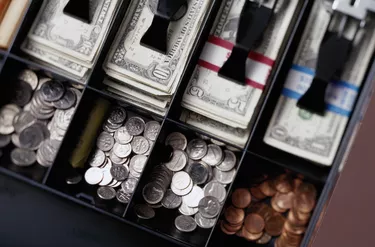
Some people claim paper money is an anachronism, destined for the scrap heap of history. Others believe that it will never die. It's convenient, it's versatile, it's accepted almost anywhere, and -- this is especially important to many -- data miners and marketers can't easily track its use. The adoption of paper money had obvious economic implications, but its acceptance also influenced other facets of our lives.
A Substitute for Value
Video of the Day
According to the International Bank Note Society, paper money first emerged in China in the 11th century. However, the concept of "printed" money -- albeit imprinting mediums such as clay tablets, wood or leather -- goes back even further. Printed paper money originally took the form of deposit receipts and ownership titles. Instead of hauling around gold bars or livestock to conduct deals, people were able to pay with pieces of paper that ultimately could be exchanged for goods. People could then pass on those pieces of paper as payments to third parties. These exchanges facilitated commerce considerably and helped economies evolve beyond the barter system.
Video of the Day
Advantage Over Coinage
After Marco Polo visited China in the late 13th century, he returned to Europe with tales of a society that used paper money. People found the idea so ridiculous they thought he was exaggerating. Europeans had long used money, but largely in the form of coins -- gold or silver or, at the very least, something with substance that "felt" as if it had value. It took several hundred years for people to recognize the convenience of carrying money in the form of banknotes that could be folded into a pocket or purse rather than lugging sacks or chests filled with coins.
A Revolutionary Idea
During the 17th century, paper money wasn't just a convenience in the American colonies, but a necessity. According to the Federal Reserve, there just weren't enough coins to go around, so colonial governments fired up the printing presses. During the Revolutionary War, the Continental Congress printed paper currency to finance the battle for independence. The first truly national U.S. currency -- the words "United States" first appeared on the notes in 1777 -- these dollars were backed by the promise of tax revenues a newly independent American nation would soon collect. In a sense, this circulation of paper money helped undergird a new national identity.
A Means of Economic Control
The widespread acceptance of banknotes depended on whether people believed they could ultimately exchange the currency for something truly valuable, such as gold or silver. In both Europe and the early United States, that trust often was lacking. Besides the government, banks, merchants, traders and just about anyone with a printing press could run off banknotes, even if nothing of value supported the currency. Chaos predictably ensued, so national governments stepped in to regulate (or, as some would say, monopolize) the printing of paper money, just as governments had regulated the minting of coins. This gave the state an unprecedented level of control over the economy. Governments could influence prices and economic activity by running, or not running, the presses.
You Can Take It With You
Today, paper money isn't backed by anything except the government's guarantee that it's worth something. The United States went off the gold standard for good in 1971. Which means that $20 bill in your pocket is nothing more than paper (cloth, actually) and ink. It's "worth" $20 because people will give you $20 worth of stuff for it. And yet paper money remains an essential part of the U.S. economic system. Although modern shoppers can pay for things simply by swiping a card or tapping a smartphone, cash remains the most popular method of payment. Part of its popularity comes down to accessibility. Since it's easy to find currency exchanges in so many countries, you can use paper money almost anywhere.